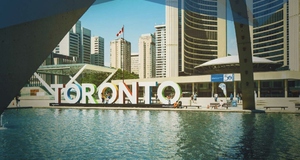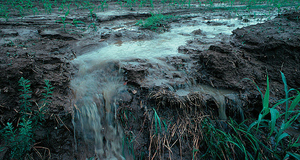From Earth Common Journal VOL. 4 NO. 1The Right and the Good: Communicating Environmental Issues
IN THIS ARTICLE
KEYWORDS
AbstractWhat we see is partially dependent on what we are shown. As communicators, we have a duty to inform and educate and lead. As environmental communicators we have the privilege of explaining how the various parts of our natural world work, individually, in unison, and in relationship to people. By examining two specific areas of growing global concerns, this paper provides an analytic tool and starts a discussion as to what should be guiding decisions concerning major environmental questions. The first growing global concern discussed is tailings ponds in Northern Alberta’s oil sands. The second is the large bodies of air pollution in Asia. In both cases, (Good) short term decisions that benefit a few have led to large environmental concerns. Should humanity be worried about our future? Could (Right) long-term, sustainable, and inclusive decisions lead to more manageable environmental challenges? To be a communicator in the real world it is important to know and differentiate between the Good and the Right. Good and Right communications in environmental issues support daily or frequent acts concerning any or all of three critical areas: sustainability, conservation, and climate change. Questions are addressed. Where are people now with respect to environment, how did we get here, and what are the pros and cons of changing from Good to Right solutions? By looking at one individual’s choice, readers see that Good and Right decisions do not have to be mutually exclusive. Introduction"Relativity applies to physics, not ethics" - Albert Einstein (1879-1955) Why worry? Populations and economies are growing. Food is available. People are healthy, and if people are not, healthcare is available. Society is making Good decisions that satisfy current needs and keep concerns away. Major challenges, such as environmental sustainability, seem far away and do not really affect us. Why worry? Norton (1982) points out that the world functions as a large integrated system. Technical or Good corrective measures that keep things working in the short term usually cause other problems in connected systems (McEwen, 1984, p. 19). Incidences of regional pollution amplify if ignored. Recent stories of increasing air pollution in Asia and other parts of the world are indications. Some products of industry and mining such as oil sands wastes are being collected until technology can be created to handle the new toxins (if these toxins can be handled). In this way small concerns have become worldwide environmental worries. This paper focuses on two specific areas of these growing global concerns. The first area of focus is tailings ponds in Northern Alberta’s oil sands. Tailings are wastes that will need to be dealt with by future generations, who do not benefit from the oil sands that the world uses now. The second area of focus is the large bodies of air pollution in Asia that are threatening air quality of neighboring states and possibly the world. In this case, some people who suffer the consequences do not receive benefits of the actions that create the pollution. In both cases, Good short term decisions that benefit a few have led to large environmental concerns, environmental concerns which become the responsibility of others. Could (Right) long-term decisions, which are sustainable and inclusive, lead to more manageable environmental challenges? If so, how does society move from making Good to Right decisions? Dr. Gwynne Dyer (2014) provides some insight into the conditions that have contributed to a paradigm shift in another social concern. Rather than war with pollution, Dyer is concerned with war between people. Dr. Dyer is an officer of the Order of Canada, freelance journalist, columnist, broadcaster and lecturer on international affairs. He spoke in Edmonton as part of Athabasca University’s Focused on the future of Learning series, titled “What the First World War Taught Us.” Dyer said, “Before that war, doing battle to settle disputes was not really considered a problem. It was just a cost of doing business” (March 19, 2014). Battles were considered in a similar manner as pollution and environmental concerns are considered today. Armies that were small in number fought conflicts, infantry were men unable to make a living any other way, and weapons had limited killing power. “War was someplace else, it affected other people” (Dyer, 2014); so, why worry? World War One changed attitudes. Armies are now huge. People fighting are our children (specialized and very well trained), and weapons are precise, expensive, and lethal. War now affects everyone (Dyer, 2014). Looking at the decisions being made about our living environment, can comparisons be drawn? Pre-industrialization pollution was natural, dispersed, and tiny in comparison to the life-threatening and toxic wastes humankind creates today. Battles fought for the environment were considered simple skirmishes, a “cost of business.” Incursions happened on small and usually sparsely populated areas. Today, all of humanity is engaged in the war. Environmental issues now affect everyone. This paper provides an analytic tool to start a discussion as to what really should guide answers to major environmental questions. DiscussionApplying aspects of recent examples to historic decisions indicate trends in environmental stewardship and demonstrate a growth and a connection between the beginning of human conservation efforts and now. Connecting decisions show how the Right and Good of communicating environmental issues support daily or frequent acts concerning sustainability, conservation, and climate change. Right and GoodDr. William Meacham (2011) provides an effective definition of terms in “The Good and The Right.” According to Meacham, something is Right if it adheres to laws or rules that have been decided because humans live in groups and require organization and regulations that help us get along. Rules ensure equality (among those involved) and quality (of things involved) are maintained. Society as a whole decides what is Right. Being Right is decided upon by one’s conformance to the social rules, or by doing one’s duty according to personal beliefs. However, Good decisions achieve a goal or target for only one group within society. Being Good means a desire is satisfied for a group and not the whole of society (Meacham, 2011, para. 1-21). An example of a Good decision is a person walking across an empty street while “don’t walk” flashes on the crosswalk signal. This person reaches the goal of crossing the street faster. The Right thing, conforming to the societal rule of obeying the crosswalk signal, is considered unnecessary at that time. The debate in Canada’s parliament about reducing the penalty for marijuana possession is another example. Josh Wingrove of The Globe and Mail quotes Alan Young, an associate professor at York University’s Osgoode Hall Law School: “The police [responsible for enforcing laws] turn a blind eye to marijuana quite often because they really don’t believe it’s a serious crime” (March 5, 2014). In this case, police are doing the Good thing by deciding to ignore a law. At the same time they are doing the Right thing by cooperating with lawmakers so that the law can be changed. Police see the law as ineffective and unnecessarily harmful to those charged. Government, representing all of society, is now reassessing the law. Good decisions in the environment assume problems as challenges to be met and overcome by an individual, group, or organization. These are competitive in that the first group to solve the challenge can sell the solution. Engineers, for example, may be employed to resolve a problem without addressing the terms that lead to the problem in the first place. This Good solution presumes that humans are in control of systems. The thinking seems to be that if a problem presents itself, society can solve it. Right decisions are aimed at preventing environmental challenges from becoming problems by setting either rules and regulations or limits (thresholds) for pollutants. Following these dictates is meant to balance all aspects of economy, environment, and ecology. Right decisions include all points-of-view and are re-examined when new evidence is discovered. These are cooperative and assume that human beings are members of the environmental ecology. The idea has history. In 1967, Lynn White argued, in her article in Science titled “The Historical Roots of Our Ecological Crisis,” that western society must step away from our sense of superiority and obtain a partnership with nature. White suggests that the ideals that allow western society to arrogantly use nature are Christian and neo-Christian in origin and so people should be converted to a new belief (pp. 1205-1207). John Passmore (1974) provides a conclusion similar to White’s 1967 argument in his book, Man’s Responsibility for Nature. He writes on the history of moral judgment according to Aldo Leopold who published thirty-five years earlier in 1949. Passmore’s descriptions of the development of human, environmental decision-making can be stated as follows:
Suggested Reading from Inquiries Journal
Inquiries Journal provides undergraduate and graduate students around the world a platform for the wide dissemination of academic work over a range of core disciplines. Representing the work of students from hundreds of institutions around the globe, Inquiries Journal's large database of academic articles is completely free. Learn more | Blog | Submit Latest in Environmental Studies |

















